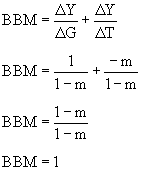Dr. Barry Haworth
University of Louisville
Department of Economics
Economics 202
Closing Output Gaps with Fiscal Policy
Suppose the economy experiences an output gap whereby equilibrium
GDP = 8800 and Potential GDP = 9000. This is a recessionary gap, because the
equilibrium GDP is less than the Potential GDP. Our desire is to close the gap,
and in order to do so, we will chose some type of fiscal policy. That is, we
will either change taxes or government spending in order to close this recessionary
gap of 200.
Before we proceed, letís remind ourselves of how this economy works. Here are
the equations for the various components of aggregate expenditure.
| C = 0.75(DI) + 400 |
(C = consumption expenditure, DI = disposable income) |
| I = 1200 |
(I = investment expenditure) |
| G = 1600 |
(G = government expenditure) |
| X = 500 |
(X = exports) |
| M = 600 |
(M = imports) |
| T = 1200 |
(T = tax revenue) |
| Yp = 9000 |
(Yp = potential real GDP) |
From this information, we derived an equation for AE, which was AE = 0.75Y + 2200.
That is, we have aggregate expenditures (AE) that rise by 75 cents for every
dollar increase in GDP (Y), but can go no lower than 2200.
If the government is using fiscal policy to close this recessionary gap, then what
happens? Weíll consider three possible approaches and look at each in turn below.
(a) change (only) in government expenditure
(b) change (only) in taxes
(c) change in both government expenditure and taxes (by the same amount)
Changing Government expenditure (only)
If we use (only) government expenditure to close a recessionary gap of 200, then
we do the following. The government must determine how much to change government
spending (G) by in order to raise equilibrium GDP (Y*) by 200. Multiplier analysis
tells us that thereís a relationship between government spending and real GDP that
looks like this:

Given the assumptions going into this example, we know that this relationship is
constant. That is, we know that by plugging in a value for the MPC and either
the change in Y or change in G, we can get a solution for the remaining variable.
What do we know here? We know that we want to increase Y by 200 and that the
MPC = 0.75. Plugging those values into the government expenditure multiplier above we get:

Solving for
DG, we get
DG = 50. That is, a
$50 increase in government expenditure will close a recessionary gap of $200.
Changing Taxes (only)
Using (only) taxes to close a recessionary gap of 200, then we do the following.
As before, the government must determine how much to change taxes (T) by in order to
raise equilibrium GDP (Y*) by 200. Multiplier analysis tells us that thereís a
relationship between taxes and real GDP, as well, which looks like this:

Given the assumptions going into this example, we know that this relationship is
constant. That is, we know that by plugging in a value for the MPC and either the
change in Y or change in T, we can get a solution for the remaining variable.
What do we know here? We know that we want to increase Y by 200 and that the
MPC = 0.75. Plugging those values into the government expenditure multiplier above we get:

Solving for
DT,
we get DT = -200/3.
That is, a $200/3 decrease in taxes (about $66.67) will close a recessionary gap of
$200. If the economy includes 67 people, then this result implies that each of the
67 individuals should pay about $1 less per period.
Changing government expenditure and taxes by the same amount
If the government decides to change taxes and government expenditure by the same amount
to close this recessionary gap of 200, then our approach is a little different from
what was described with taxes (only) and government expenditure (only). When G and
T change by the same amount, we talk about actions designed to keep the budget
balanced. Therefore, itís relevant to ask about the net effect of changing G and
T by the same amount, which leads to a discussion of the balanced budget multiplier.
What is the combined effect of changing G and T by the same amount? G is expansionary,
and T is contractionary. Because G affects GDP directly and T indirectly, we expect a
net GDP increase from increasing G and T by the same amount (and a net GDP decrease from
decreasing G and T by the same amount). If we simply add the two multipliers together,
and assume that
DG =
DT, we get the
balanced budget multiplier.

What this result tells us is that any equal increase (or decrease) in government
spending and taxes will cause the same increase (or decrease) in equilibrium GDP.
In this situation, all we need to do is to change G and T by the amount of the
recessionary gap.
That is, if government spending and taxes both increase by $200, then equilibrium
GDP will increase by $200 as well.
